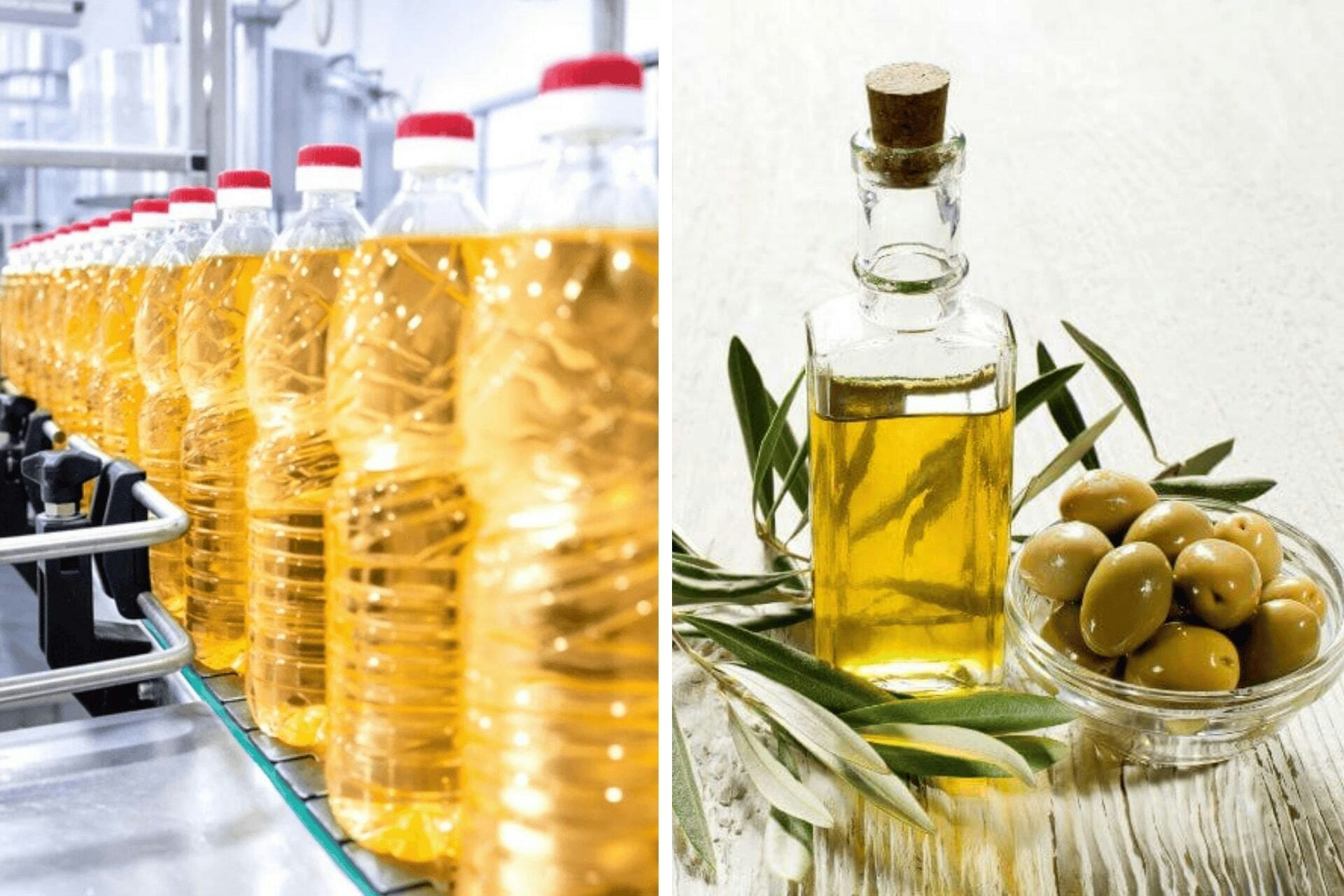Are you ever confused about which oil to use when cooking? You might have heard people talking about “refined” and “unrefined” oils, and wondered what the difference really is.
The truth is, there’s more to it than just a label on the bottle. Oils can be processed in different ways, which can change their flavor, color, and even how they work in cooking.
This article breaks down what refined and unrefined oils are, compares them side by side, and explains when you might want to use each one. We’ll also help you understand how to tell them apart and answer common questions like whether unrefined oils are healthier or if you can use them for frying.
Understanding Oil Classification
You’ve probably noticed that cooking oils come with all kinds of labels — “virgin,” “crude,” “refined” — and wondered what they actually mean. The difference lies in how the oil is extracted and processed.
There are two main ways to extract oil from seeds, nuts, or fruits: mechanical extraction and solvent extraction. Mechanical extraction uses physical pressure to squeeze oil out of the source material. This can be done in several ways:
- Centrifuge extraction is common for olives and avocados.
- Hydraulic pressing is used for roasted nut oils.
- Continuous screw pressing (expeller pressing) is typical for most seeds.
Temperature control plays a key role during this process. When the pressing temperature stays below 100°F, the result is known as cold-pressed oil, which helps preserve the oil’s natural nutrients, flavor, and quality ❶.
Oils that are mechanically extracted and don’t need further processing are called virgin oils, while those requiring refining are known as crude oils.
Solvent extraction, by contrast, is often used for large-scale oil production. It involves using a chemical solvent, usually hexane, to pull oil from plant material. This method extracts nearly all the oil, making it very efficient. However, because it uses chemicals, the oil must go through additional refining steps such as cleaning, bleaching, and deodorizing before it’s safe to eat.
While solvent extraction boosts yield, it’s not the most eco-friendly process, so researchers are now exploring cleaner, more sustainable alternatives ❷.
What is Refined Oil?
Refined oils are basically oils that have been cleaned up after they’re extracted. The refining process removes things like strong odors, unusual colors, and any leftover impurities, giving the oil a smoother taste, lighter color, and longer shelf life.
Because of this, refined oils are great for everyday cooking and especially for recipes that need high heat, like frying or sautéing.
Common examples of refined oils are:
- Canola oil
- Vegetable oil (soybean or corn)
- Sunflower oil
- Peanut oil
The trade-off? Refining can strip away some of the natural nutrients and flavors you’d find in unrefined oils. But that neutral taste and versatility make refined oils a handy staple in any kitchen.
What is Unrefined Oil?
Unrefined oils are the closest you can get to the natural oil straight from seeds, nuts, or fruits. They’re usually extracted with minimal heat and without chemical solvents, which helps them retain their natural flavor, aroma, color, and nutrients.
Because they aren’t heavily processed, unrefined oils can have a richer, more distinctive taste and often a slightly cloudy appearance.
Common examples include:
- Extra-virgin olive oil
- Cold-pressed avocado oil
- Sesame oil (unrefined)
Note: Algae cooking oil occupies a unique spot. While some brands may market it as “pure” or “neutral-flavored,” the production process is more involved than simply pressing the algae.
Typically, the process includes fermentation, oil build-up, extraction, and impurity removal. This means it’s more processed than traditional unrefined oils, but doesn’t go through heavy refining steps like bleaching or deodorizing common in seed oils.
The result is a clean, mild-flavored oil with fewer impurities, ideal for cooking, though it wouldn’t technically be classified as fully unrefined in the traditional sense.
Refined vs. Unrefined Oil
The main differences between refined and unrefined oils come from how they are processed and the effects this has on flavor, cooking properties, and nutrients.
Refined oils go through purification to remove impurities, colors, and odors, which makes them stable for high-heat cooking. Unrefined oils are minimally processed, usually cold-pressed or mechanically extracted, which helps preserve their natural compounds and distinctive flavors.
When it comes to taste, refined oils are generally neutral and light, making them versatile for a variety of dishes. Unrefined oils, in contrast, retain the natural taste of their source, such as the fruity notes of extra-virgin olive oil or the nutty aroma of sesame oil, which can enhance salads, dressings, or gentle cooking methods.
Refined oils also tend to have higher smoke points because impurities and free fatty acids are removed. This makes them ideal for frying, sautéing, or other high-temperature cooking. Unrefined oils have lower smoke points and are better suited for drizzling, dressings, or low-heat applications.
Nutritionally, unrefined oils usually contain more antioxidants, vitamins, and other natural compounds, while refined oils may lose some of these beneficial nutrients during processing.
Refining also extends shelf life by removing elements that can spoil, making refined oils more stable over time, whereas unrefined oils are more delicate and can become rancid faster if exposed to heat, light, or air.
| Refined Oil | Unrefined Oil |
| Processing | Purified, may include chemical steps | Minimal processing, usually cold-pressed |
| Flavor | Neutral, light | Distinct, rich, retains natural taste |
| Smoke Point | High, suitable for frying | Lower, best for low-heat cooking or dressings |
| Nutrients | Fewer antioxidants and natural compounds | Retains most natural nutrients and antioxidants |
| Shelf Life | Longer, more stable | Shorter, more prone to rancidity |
When to Use Refined vs. Unrefined Oils
Refined oils are your go-to when you need something versatile and stable for high-heat cooking. They work well for frying, sautéing, or baking because their neutral flavor won’t overpower the recipe, and their higher smoke point means they can handle the heat without breaking down.
Unrefined oils, on the other hand, shine when you want to highlight flavor or preserve nutrients. Use them for salad dressings, drizzling over cooked vegetables, or gentle sautéing at lower temperatures. Their natural aroma and taste can add a noticeable boost to dishes, but their lower smoke point means they aren’t the best choice for deep-frying or prolonged high-heat cooking.
Algae cooking oil is a special case. It has a mild, neutral flavor and a very high smoke point of 535°F, making it suitable for both medium- to high-heat cooking. It also supports heart health due to its high oleic acid content, which is rich in monounsaturated fats.
The Bottom Line
Choosing the right oil doesn’t have to be confusing. Refined oils are great for high-heat cooking and recipes where you want a neutral flavor, while unrefined oils shine when you want to preserve natural flavors and enjoy a richer taste.
If you’re looking for an oil that combines versatility, high-heat stability, and heart-healthy benefits, algae cooking oil from Algae Cooking Club is worth considering. With its mild flavor, extremely high smoke point, and healthy monounsaturated fats, it can be a staple in a variety of dishes.
FAQs
Is unrefined oil healthier?
Unrefined oils retain more of their natural compounds, antioxidants, and flavor compared to refined oils. This can make them more nutrient-rich, but “healthier” depends on how you use them and your cooking method, since their lower smoke points limit high-heat applications.
How do I know if my oil is refined or unrefined?
Check the label for terms like “virgin,” “extra-virgin,” or “cold-pressed” for unrefined oils. Oils labeled simply as “refined” or that list chemical processing or bleaching are refined.
Is organic oil the same as refined oil?
Not necessarily. Organic refers to how the source plant was grown, not how the oil was processed. You can have organic refined oils and organic unrefined oils.
Can I fry with unrefined oil?
It’s generally not recommended because unrefined oils have lower smoke points and can break down at high heat. For frying, refined oils or high-smoke-point oils are safer choices.




